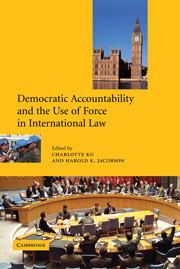Book contents
- Frontmatter
- Contents
- List of figures
- List of tables
- Notes on contributors
- Preface
- List of abbreviations
- I Introduction
- II The domestic and international context
- III Traditional contributors to international military operations
- IV Newcomers to international military operations
- V Permanent members of the UN Security Council
- 11 Russian Federation: the pendulum of powers and accountability
- 12 France: Security Council legitimacy and executive primacy
- 13 The United Kingdom: increasing commitment requires greater parliamentary involvement
- 14 The United States: democracy, hegemony, and accountability
- VI Conclusion
- Appendix A. Uses of military forces under the auspices of the UN and NATO
- Appendix B. Country participation in international operations, 1945–2000
- References
- Index
14 - The United States: democracy, hegemony, and accountability
Published online by Cambridge University Press: 30 July 2009
- Frontmatter
- Contents
- List of figures
- List of tables
- Notes on contributors
- Preface
- List of abbreviations
- I Introduction
- II The domestic and international context
- III Traditional contributors to international military operations
- IV Newcomers to international military operations
- V Permanent members of the UN Security Council
- 11 Russian Federation: the pendulum of powers and accountability
- 12 France: Security Council legitimacy and executive primacy
- 13 The United Kingdom: increasing commitment requires greater parliamentary involvement
- 14 The United States: democracy, hegemony, and accountability
- VI Conclusion
- Appendix A. Uses of military forces under the auspices of the UN and NATO
- Appendix B. Country participation in international operations, 1945–2000
- References
- Index
Summary
To the proverbial Martian who steps out of a flying saucer and asks what American law is concerning the use of force, the United States would represent a conundrum. Although its legal regime in this area is among the most elaborate on the planet, its political culture seems out of step with that regime. Its Constitution provides that war shall be declared by Congress – yet armed force has been used well over 200 times throughout its history, and in only five conflicts has Congress declared war. A law enacted following the Vietnam War, the War Powers Resolution, was aimed at restoring the “partnership” between Congress and the president in decisions to use armed force – yet armed force has been used even more frequently since its enactment, with Congress having approved such use only once, in connection with the Gulf War in 1991. The United States was one of the prime movers in establishing the United Nations and its collective security regime – and yet it led a massive bombing campaign at the end of the twentieth century that flouted that regime. What, the Martian might ask, is going on in this country?
The law governing use of force by the United States
The introduction of United States armed forces into hostilities is governed by a complicated mix of constitutional and statutory provisions. That regime is designed in part to render those who order and direct the use of force accountable to democratic control.
- Type
- Chapter
- Information
- Publisher: Cambridge University PressPrint publication year: 2003
- 3
- Cited by



